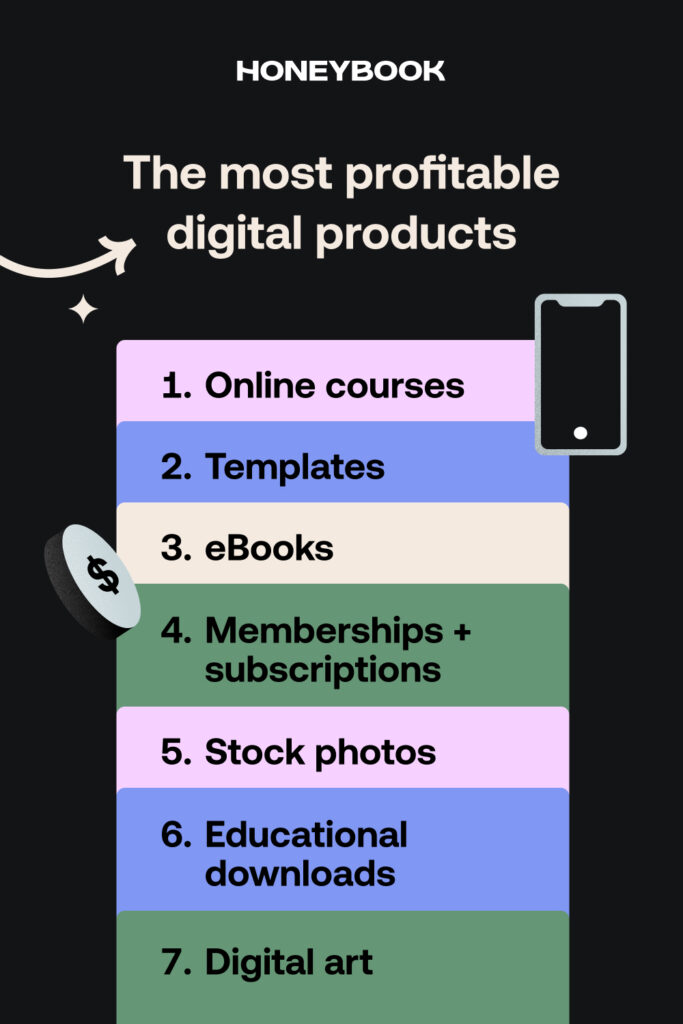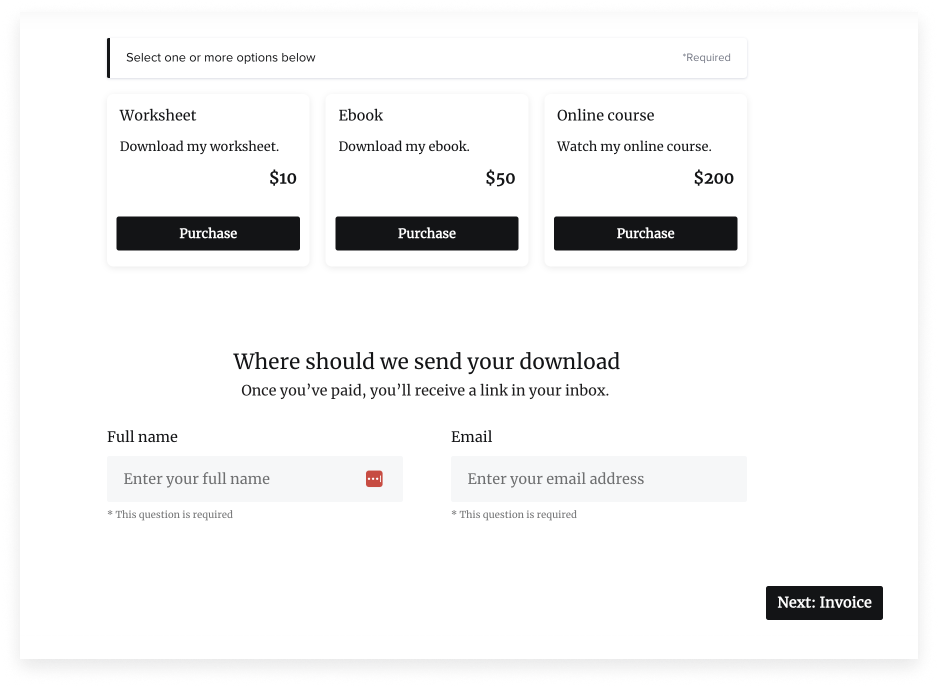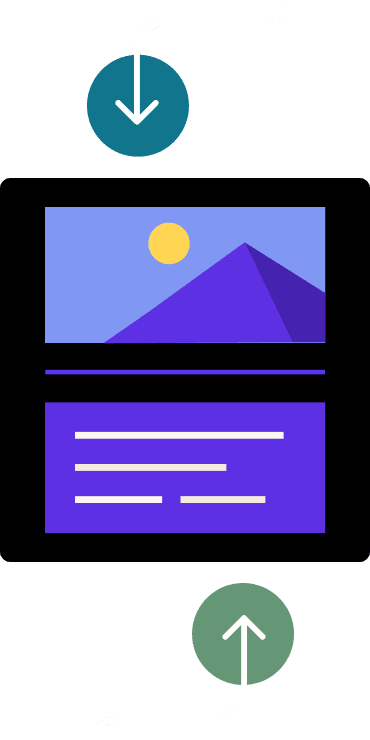By reaching your target customers with digital products, you can generate extra income and create a more powerful brand. Explore some of the most profitable digital product ideas to increase your revenue.
There’s always been an inconvenient truth for service-based businesses: If you want to make more money, get more clients. But when you’re trading time for money and your client roster has limited capacity, unfortunately, your earnings do too.
If you’re an independent business owner who has ever felt frustrated by the feast-famine struggle or you simply want to increase your revenue without increasing your workload, digital product sales offer a solution. Selling digital resources that complement your services — from downloadable PDFs to online courses — can help you bring in a secondary income stream. You can even manage your client work and products all in one place.
Digital products not only help service providers increase their revenue, but they can help you sustain growth, create passive income streams, and reduce your working hours. And it’s easy and inexpensive to get started.
So, if you’re ready to jump into the world of online digital content, read on to discover the most profitable digital products for service providers.
Jump to:
- What are digital products?
- Online courses
- Templates
- Ebooks
- Educational memberships or subscriptions
- Stock photos
- Educational downloads
- Digital art
- How to choose a profitable digital product to sell
- What do I need to start selling digital products?
What are digital products?
A digital product is an online resource that provides useful information to whoever buys it. From a downloadable checklist or ebook to a full video course or membership subscription site, digital products come in a wide range of formats.
Selling digital products can be a highly scalable — and profitable — model to increase revenue through passive income. Typically, once you’ve created your product, you can sell it time and again with little to no additional time investment or fulfillment costs.
It is possible to create and sell digital products on literally any topic that adds value to your audience. As a service provider, a great strategy is to create and sell relevant digital products alongside your services, offering additional value to your client base. For example, if you work in marketing, this could look like selling downloadable email marketing templates or a video masterclass on how to do cold outreach. Not only can offering additional resources help you boost earnings, but it will also increase authority and trust with your audience at the same time.
The great thing about digital products is that they are low-risk. Many products don’t require a significant investment, and you can slowly build up your digital sales alongside your main service offerings.
Start reaping the benefits of selling digital products today with these seven profitable digital product examples for service providers.

1. Online courses
By 2028, an estimated 1 billion people will use online courses, so it’s the perfect time to get started. Online courses allow you to share your skills with others, rather than the traditional done-for-you approach of service businesses. They can be highly lucrative digital products, as their perceived value is high. Once developed, you can also sell them repeatedly without limitations.
Courses usually include a combination of video lessons, written content, and downloadable resources. Service-based business owners can capitalize on their existing client base, offering them a chance to deepen their understanding through additional content. Courses can enhance customer loyalty while attracting new clients and building authority at the same time.
To ensure profitability and avoid wasted time and effort, validate the idea with your market before you create your course. This could involve conducting client interviews or asking your social media accounts to ensure people are interested. We also recommend selling your course before you make it. This might sound strange, but trialing the course with a live cohort will allow you to adapt the material as you go based on real-time feedback and ensure you don’t invest months into something that doesn’t sell. You can then use the recordings each week to create the basis of your course.
2. Templates
While simple to create, templates can be an extremely valuable resource. These pre-designed, done-for-you resources are customizable, helping clients save time and improve results in tasks from graphic design to project management. Templates are a great source of passive income as you can sell them unlimited times in a completely automated fashion.
You can create a template on almost any topic. Some great digital product ideas floating around the market include:
- Email marketing templates
- Logo templates
- Legal templates
- Resume and cover letter templates
- Social media caption templates
- Wedding invitation templates
Digital templates are economical to create, so they pose few risks. While unlikely to sell for as much as a course, they can be a great low-barrier resource to introduce potential clients to your work and build trust.
3. Ebooks
A high-quality ebook is a powerful way to share knowledge, stories, and expertise in a digital format. Unlike traditional publishing, ebooks have minimal costs and give you more control over the content and pricing.
To create an ebook that sells, choose your topic wisely. Your book must offer value to your target audience, as well as be engaging and actionable. Formatting and appearance are also vitally important. The book should have an attractive, clear, and professional cover and an easy-to-follow structure with clear headings.
You may sell your ebook independently as a simple PDF or turn to online stores like Amazon, Kindle, or Etsy. Aside from monetary gains, creating and selling an ebook can help you establish yourself as an authority in your field.
4. Educational memberships or subscriptions
For independent business owners aiming to broaden their impact, establishing a membership can be a strategic move. This model commonly operates on a monthly subscription basis, granting members access to diverse content via a dedicated platform.
A membership offers clients a lower-cost, more casual way of working with you. Members can access content at their own pace, and once it’s all set up, you don’t need to invest much time.
Depending on the membership model you choose, you might offer varying types of content:
- On-demand tutorials
- Community groups
- Live masterclasses
- Group coaching sessions
- Exclusive content
- Downloadable resources
Running a membership requires investing in a hosting platform where you can efficiently manage and deliver your content. You’ll need to regularly update content and offer new benefits to stop members from canceling their membership.
5. Stock photos
We all know how generic and uninspiring stock photos can be. For any photographers out there, why not create and sell your own images to generate additional income?
One of the easiest ways to get started is to sell your photos to existing stock websites, such as:
- Alamy
- 500px
- Smugmug
- Shutterstock
- Getty
- Stocksy
- Adobe Stock
These sites typically offer a set payment or royalties scheme for your photos.
Alternatively, you may be able to license your images and sell your photos independently as digital files. Types of licenses include commercial and non-commercial rights, exclusive and non-exclusive rights, and one-time use, among others. You could even create your own content library. If you choose this path, you’ll need a strong marketing plan to sell your images.
6. Educational downloads
Whether you’re a coach, writer, marketer, or artist, you can create and sell educational content in the form of downloads. Downloadables are usually cheap and simple to build, so you can begin selling them within days.
Popular digital downloads include:
- Checklists
- Guides
- Workbooks
- Planners
- Lists of valuable information, such as resources or events
For example, a writer might sell an SEO checklist so clients can improve their own blog posts, while a designer might sell a guide listing the key pillars for a highly converting website.
Downloadable educational products are fairly low-cost items among digital products. Try upselling these to clients as extras alongside your services, or use them to build trust with potential clients before they commit to working with you by adding them to lead forms. An educational download also makes a great freebie that you can use to grow your email list.
Pro tip
You can sell digital files from your own website or list them on an online marketplace like Amazon or Etsy. There are also plenty of tools that help you securely store and deliver your products, like HoneyBook.
7. Digital art
Calling all artists and designers! Have you ever thought of selling digital art? Instead of spending hours on a piece only to make a single sale, you can digitize your work and sell it again and again. And with the online art market reaching $9.18 billion in 2022, there’s never been a better time to get a piece of the pie.
If you create art digitally, you can simply sell the digital files as downloadable prints. Otherwise, you can digitize physical pieces with high-quality photos or scanning. An alternative to selling digital files is to work with an on-demand printer that can print and fulfill orders as they come in. You could even print your art onto physical products like tote bags.
Marketplaces like Etsy and Redbubble are great places to get started with selling, as you can tap into a ready-made audience. However, they take commissions and fees, so setting up your own online store would give you more control.
How to choose a profitable digital product to sell
Choosing the right digital product type is key to making sure it sells.
Brainstorm your existing skills
A digital product should offer immense value to the target audience, so consider creating a product based on your unique professional skills and experience. If you help clients achieve a transformation in your service-based business, is there a way you can templatize processes, run a masterclass, or create a done-with-you resource?
Research your audience’s problems
A digital product that solves a specific problem for your client is irresistible. Conduct market research to find your target audience’s most pressing problems. You can do this by setting up phone interviews with existing clients, researching forums and social platforms where the target spends time, or asking your email list or social media audience (if you have one).
Pro tip
Consider which online services you offer that get booked the most. Taking these and turning them into digital assets for potential customers is a quick way to come up with new ideas for digital products.
Follow your preferences
To get started, let your personality and preferences help you decide. If you’re not a fan of being on camera, consider a written ebook or downloadable product. If you love teaching, try an online course or masterclass. Loving what you do will help your digital product be successful.
What do I need to start selling digital products?
Selling digital products may seem confusing at first. Not only will you need the right tools to create them, but you also have to generate interest, take online payments, deliver the product when someone buys it, and grow your brand. Here’s what you’ll need to have:
Tools to create your product
There are multiple free and paid tools available to help you create your digital product. You can get started creating downloadable PDFs, checklists, or templates on a simple Google Doc or using a free Canva template. To create video content, it’ll help to have a good-quality camera, lighting equipment, and editing software. To host online courses, check out course platforms like Kajabi, or for a community or membership, try tools like MemberUp. For creating digital art, nothing can beat Adobe Suite.
A platform to sell digital products
To sell digital products you might set up an online store on your website, using WooCommerce or Shopify to automate the sales process. You may also choose to use a marketplace such as Etsy. However, one of the quickest ways to start making sales as a service provider is to upsell to your existing clients or potential clients.
HoneyBook is an all-in-one clientflow tool for service-based businesses that makes it easy for you to manage your clients and billing. It has a simple feature to help you add digital products to your lead forms. Whenever new clients express interest in your services, they’ll automatically receive an offer to buy your product. You can make sales while you sleep; enable this feature in just a few clicks. HoneyBook even processes online payments, so you can keep track of all your business revenue in one place.

A process to nurture your digital product customers
Once your sales systems are ready, it’s time to build a steady stream of customers. An email list is one of the most effective and sustainable ways to reach and nurture a list of potential buyers. Try creating a freebie or opt-in to gather emails. You can then send your list valuable content to build trust.
Strategies to market your digital products
Marketing your products is vital if you are serious about growing your sales and passive income. Building a presence and audience on social media is important in order to become an authority in your industry. Find out which platforms your ideal clients hang out on — Instagram, LinkedIn, and TikTok, for example — and focus your efforts there. Posting consistently and providing value is key for audience building.



